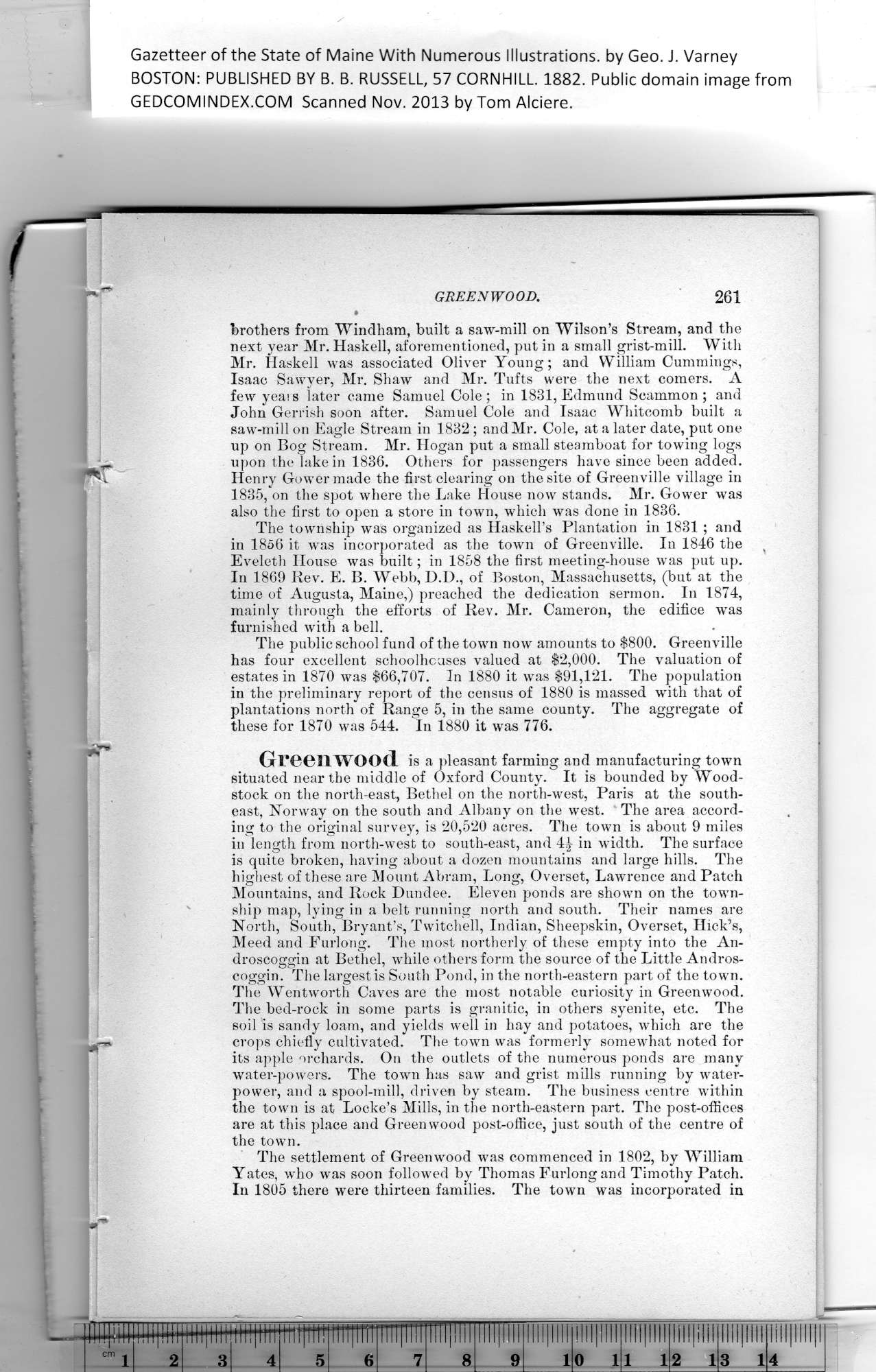|
Gazetteer of the State of Maine With Numerous Illustrations, by Geo. J. Varney
BOSTON: PUBLISHED BY B. B. RUSSELL, 57 CORNHILL. 1882. Public domain image from
r GREENWOOD. 261
•
brothers from Windham, built a saw-mill on Wilson’s Stream, and the
next year Mr. Haskell, aforementioned, put in a small grist-mill. With
Mr. Haskell was associated Oliver Young; and William Cummings,
Isaac Sawyer, Mr. Shaw and Mr. Tufts were the next comers. A
few years later came Samuel Cole ; in 1831, Edmund Scammon ; and
John Gerrish soon after. Samuel Cole and Isaac Whitcomb built a
saw-mill on Eagle Stream in 1832 ; and Mr. Cole, at a later date, put one
up on Bog Stream. Mr. Hogan put a small steamboat for towing logs
^ upon the lake in 1836. Others for passengers have since been added.
1 Henry Gower made the first clearing on the site of Greenville village in
1835, on the spot where tbe Lake blouse now stands. Mr. Gower was
also the first to open a store in town, which was done in 1836.
The township was organized as Haskell’s Plantation in 1831 ; and
in 1856 it was incorporated as the town of Greenville. In 1846 the ^
Eveleth House was built; in 1858 the first meeting-house was put up.
; In 1869 Rev. E. B. Webb, D.D., of Boston, Massachusetts, (but at the
| time of Augusta, Maine,) preached the dedication sermon. In 1874,
mainly through the efforts of Rev. Mr. Cameron, the edifice was
! furnished with a bell.
The public school fund of the town now amounts to $800. Greenville
has four excellent schoolhouses valued at $2,000. The valuation of
estates in 1870 was $66,707. In 1880 it was $91,121. The population
in the preliminary report of the census of 1880 is massed with that of
plantations north of Range 5, in the same county. The aggregate of
these for 1870 was 544. In 1880 it was 776.
Greenwood is a pleasant farming and manufacturing town
situated near the middle of Oxford County. It is bounded by Wood-
stock on the north-east, Bethel on the north-west, Paris at the south-
east, Norway on the south and Albany on the west. The area accord-
ing to the original survey, is 20,520 acres. The town is about 9 miles
in length from north-west to south-east, and 4-J in width. The surface
is quite broken, having about a dozen mountains and large hills. The
highest of these are Mount Abram, Long, Overset, Lawrence and Patch
Mountains, and Rock Dundee. Eleven ponds are shown on the town-
ship map, lying in a belt running north and south. Their names are
North, South, Bryant’s, Twitchell, Indian, Sheepskin, Overset, Hick’s,
Meed and Furlong. The most northerly of these empty into the An-
droscoggin at Bethel, while others form the source of the Little Andros-
coggin. The largest is South Pond, in the north-eastern part of the town.
The Wentworth Caves are the most notable curiosity in Greenwood.
The bed-rock in some parts is granitic, in others syenite, etc. The
soil is sandy loam, and yields well in hay and potatoes, which are the
crops chiefly cultivated. The town was formerly somewhat noted for
its apple orchards. On the outlets of the numerous ponds are many
water-powers. The town has saw and grist mills running by water-
power, and a spool-mill, driven by steam. The business centre within
the town is at Locke’s Mills, in the north-eastern part. The post-offices
are at this place and Greenwood post-office, just south of the centre of
the town.
The settlement of Greenwood w7as commenced in 1802, by William
Yates, wTho was soon followed by Thomas Furlong and Timothy Patch.
In 1805 there were thirteen families. The town was incorporated in
PREVIOUS PAGE ... NEXT PAGE
This page was written in HTML using a program written in Python 3.2
|
